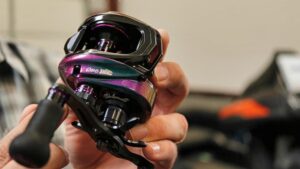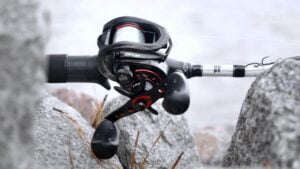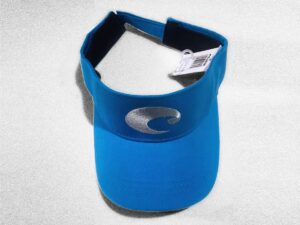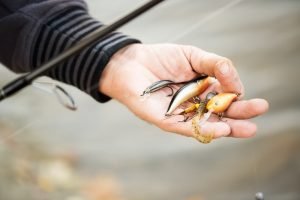Lures
The 7 Best Summer Bass Lures — Catch The Big One Despite The Blazing Heat
The Summer is a great time of year for bass fishing. Despite the heat, bass are actively biting if you know where to look. With the right lures and a few good techniques you can catch your next trophy bass this summer!
Home » The Best Bass Lures » Top 7 Summer Bass Fishing Lures
Maximize Your Summer Bass Fishing
Every season of the year poses its own unique challenges for bass fishing. The summer months are no exception.
In the summer you’re leaving the hyperactive spawn season and moving into what can be a very frustrating bass fishing experience for beginners.
As the summer heat begins to move in, the water temperatures increase and bass begin to search out cooler waters to spend their time in.
While they are still actively feeding during the summer months it’s typically restricted to the cooler parts of the day when the sun isn’t actively shining on the water.
Top 7 Summer Lures For Bass Fishing
In this article we’ll be discussing 7 of the best summer bass lures as well as some tips and tricks to make the most of your summertime fishing. If you’re looking for bass lures that work great year round, check out our article: Top 20 Bass Lures of All Time.
Topwater Frog
Type: Topwater Bass Lure
If you want to catch bass, you have to be able to imitate the things that they eat. One of the staples of their diet is frogs.
That’s why topwater frog lures are such an effective bait to use and so popular among bass fishermen. Not only do they have a frog look to them, but by imitating the movements and behaviors of a frog your lure can easily look like the real thing. Making them a perfect lure for bass.
Topwater frogs work great in areas that frogs would normally hang out. Think lily pads, thick grassy areas in the water, logs, etc. Frogs can be a great addition to your fishing arsenal as they let you fish in areas that you’d never throw another type of lure.
They come in just about every color and design. Once you get the hang of them, they are simple to use: Cast them out, let them rest, twitch them around, and reel them in when you’re ready to reposition into a new location.
The key is to think about how a frog would actually act out on the water and try to replicate it. When the bass hits the lure, give it a good jerk and hook the bass.
The whole process does take some getting used to.
When first starting out with a frog, you may try to set the hook too quickly and end up missing the bass. Just be patient with yourself until you get the hang of it.
Once you do, topwater bait can be a lot of fun and provide some amazing visuals of the bass striking the lure.
Recommended Topwater Frog:
Croch Hollow Body Weedless Frog Lures
We recommend the Croch Hollow Body Weedless Frog Lures. They come in a kit that includes 18 various colors and shapes.
Recommended Rig Setup:
- Rod: 6’5″ – 7’3″ Heavy action up to extra heavy action
- Reel: 7.1:1 to 8.1:1 gear ratio
- Line: 50-65 lbs braid
Looking for more information on frog lures? Read our article — 11 Best Frog Lures For Bass.
Zara Spook
Type: Topwater Bass Fishing Lure
The Zara Spook is the original walk-the-dog topwater lure invented by Heddon over 75 years ago. It is a true classic!
This legendary lure is just the right size and produces a life-like swimming action when retrieved using the unique walk-the-dog retrieval technique.
Walking the dog with a Zara Spook is a great way to attract bass that are not striking other lures.
Walk the Dog is a technique that many anglers use to emulate the action of a baitfish moving across the water.
Before fishing with this technique, first, tie your Spook with a knot that allows instant control of the lure. A knot like the Trilene Knot will work best.
Start by casting making a long cast. Make sure you give yourself plenty of room to work with.
After casting, take up most of the line slack, but don’t start retrieving the Spook. Allow it some time to rest on the water. You can measure this by letting the ripples around the lure dissipate.
Position the tip of your rod at a slight angle toward the water.
Next, twitch your rod tip around 6 inches to the left or the right. This will cause the spook to shoot in the direction of your rod twitch. You don’t want to over to this motion. You want a quick short jerk of the lure, but nothing too drastic. You can help limit yourself by utilizing your wrists only to make the movement.
After the first twitch, wait a couple of seconds and allow the Spook to pause.
You will then repeat the twitching motion, this time in the opposite direction than the first movement.
Again pause for a few moments. Go ahead and check your line. You don’t want to have too much slack as you won’t be able to deliver a good movement to your lure, but you want to avoid a tight line as the lure will just start moving back toward you too quickly.
You will now want to continue repeating this motion. Twitching the Spook to the right, pause, reel in the slack, twitch to the left, pause, reel in the slack, repeat.
By performing this zig-zag motion, you’re replicating the movement of an injured baitfish which is a great way to attract an otherwise passive bass. Bass are always in the mood for an easy meal, and a wounded baitfish is a meal that many won’t pass up.
Walking the dog with a Zara Spook is a time-proven technique and lure that has been the “go-to” bait of pros, weekend warriors, and tournament anglers alike who want to catch the biggest, fighting bass on the lake.
Recommended Zara Spook
Heddon Zara Spook Topwater Fishing Lure
We recommend the Heddon Zara Spook and really like the wounded version of the lure as it adds some extra movement that works really well on bass.
Recommended Rig Setup:
- Rod: 7’2″ Med Heavy
- Reel: 7.1:1+
- Line: 40 lbs braid
Deep Diving Crankbait
Type: Moving Bait
Deep diving crankbaits are one of the best lures to use during the summer months when fishing for bass, especially during the day. When the sun is up bass tend to hang out much deeper where the water temperature is cooler. Deep-diving crankbaits are a great way to get your bait down to the deeper water.
The best way to fish a deep-diving crankbait is to make long casts, once the lure hits the water retrieve the line very quickly for a few handle rotations. This will help get the diving crankbait down to the desired depth.
After this reel the crankbait back in with a steady retrieve. Try to keep your retrieve as constant as possible. This will help maintain the right depth.
Once you get the hang of this, you can begin adding variations to your retrieve. You can try slowing down your retrieve to allow the crankbait to come closer to the surface as well as reel faster which will make the lure go back to a deeper depth. This is an excellent way to trigger a reaction bite from a bass.
We advise using a fluorocarbon fishing line when using a deep-diving crankbait since so much of your line will be under the water. The transparent appearance of fluorocarbon will help bass from spotting your line and getting spooked.
If you’re looking for a great deep-diving crankbait, we recommend the Norman DD22.
The Norman DD22 Crankbait is a bass-catching machine.
There’s a reason that it is one of the best-selling deep-diving crankbait on the market. The DD22 will dive deep without banging the bottom, delivering your lure straight to the strike zone.
Norman’s special shaping of the DD22’s bill helps it dive and deflect off structure and cover. It is extremely durable and can take a lot of abuse.
The DD22 is an excellent choice for targeting low-hanging and suspended bass.
Recommended Deep-Diving Crankbait
Norman Lures DD22
The DD22’s uniquely shaped bill helps it dive and deflect off cover and structure. It is an excellent choice for targeting low-hanging and suspended bass.
Recommended Rig Setup:
- Rod: 7’6″ med heavy (the longer the better)
- Reel: 6.4:1
- Line: 12 lbs fluorocarbon
Square Bill Crankbait
Type: Search Bait
A square bill crankbait is an awesome lure for shallow water summer bass fishing.
The square-bill crankbait took inspiration from the traditional and lipless crankbait in order to create something the new. The primary difference is in the square shape of the lip instead of the traditional circular shape. The square shape provides more of an erratic movement during the retrieve as well as helping it bounce off of cover.
Start fishing a square bill by casting it into your targeted shallow area. Begin retrieving the lure at a quick rate until you feel it make contact with the bottom. You’ll then want to continue retrieving at a rate keeping the lure right above the floor bottom. You can also speed up the retrieve to allow it to keep bouncing off of the bottom.
Try it near structures and cover. Near rocks, riprap, logs, as well as other underwater formations. The square bill helps the lure to bounce off of what would normally catch a traditional crankbait.
Our recommended square bill is the Strike King Square Bill Crankbait. It has a unique bill design that creates a jerky fall and a wandering motion that triggers bass to strike.
They come in a variety of different sizes and colors, but we generally would recommend matching the natural look of the shad in the water you fish.
Recommended Square Bill Crankbait
Strike King Square Bill Crankbait
Strike King Square Bill Crankbait is our favorite square bill. It has a unique bill design that creates a jerky fall and wandering motion which triggers bass to strike.
Recommended Rig Setup:
- Rod: 6’10” to 7′ moderate action
- Reel: 7.3:1
- Line: 15-20 lbs fluorocarbon
Chatterbait
Type: Search Bait
No matter what your location or water conditions the Chatterbait is great lures to catch big summertime bass.
Chatterbaits pull in some of the best features from the crankbait, jig, and spinnerbait incorporating a spinning blade, vibration, as well as snag resistance.
The Chatterbait itself consists of a blade, head, skirt, and hook. It is designed to be used with a “trailer” or soft plastic bait attached to the hook. Some of the best trailers to try would include, plastic paddle tail swim bait, crawfish, worms, or any other soft plastic creature type bait.
In the summer, Chatterbaits are great to use near and around cover. Places like grassy mats, logs, and laydowns on the water edge and docks. Anywhere that bass are going to be hanging around either to escape the heat or to be looking for food.
Typically, you’ll want to cast your Chatterbait in or right up on the cover where bass are hanging out. Let the lure sit for a moment and then begin to retrieve your line. You’ll want to slow-roll your retrieve, meaning slowly turning the reel handle to allow the Chatterbait to slowly move through the water.
Occasionally during the retrieve, you’ll want to jerk your rod up, to make the lure have a quick movement through the water. This type of activity will help instigate an instinctive strike from a big bass that may be slowly following the lure.
After the quick movement go back to the slow roll retrieve.
Repeat this process until you catch that trophy bass.
As far as the best Chatterbait to use, not much can beat the original Z-MAN Chatterbait, but we’ve become fans of the upgraded Project Z model. The new head design looks more realistic and the newer model has more vibration than the original.
Overall, they took something amazing and made it even better.
We generally recommend getting the Dark Green Pumpkin color variation as we’ve had amazing success with that pattern.
Also, if you’re looking for a great trailer, we think Zoom’s Salty Super Fluke works very well.
Recommended Chatterbait
Z-MAN Chatterbait Project Z
The Project Z is an upgraded version of the original Z-MAN Chatterbait. The newer model has more vibration and the head design is more realistic than the original.
Recommended Rig Setup:
- Rod: 6’10” to 7′ moderate action
- Reel: 7.3:1
- Line: 15-20 lbs fluorocarbon
Spinnerbait
Type: Search Bait
It’s hard to beat a spinnerbait. When going through the water, spinnerbaits look like a small school of bait fish swimming by and bass absolutely destroy it.
They work great in many types of water, and their nearly weedless design helps them go through various types of cover.
In the summer spinnerbaits typically work best on cloudy overcast days with some wind blowing. On very calm sunny days, you may have better luck with a different type of lure.
When fishing with spinnerbaits, target areas with some cover. Typically, we’ll use much of the same strategies with spinnerbaits that we use with Chatterbaits.
Target grassy edges, mats, logs, laydowns, cypress roots, etc. Anywhere bass can find a good hiding spot or are looking for food will be good places to use spinnerbaits.
After the cast, you’ll typically want to use a slow to medium retrieve of the lure. Every once in a while incorporate a pause or slight jerk into the retrieve. This will add some randomness and variance to the retrieve which can help influence a passive smallmouth bass to strike.
Spinnerbaits come in different shapes and sizes, but the biggest difference between models is the type and number of blades on the lure.
The two main types of blades are Colorado blades and willow leaf blades.
Colorado blades are larger and have less flash to them. They will typically cause more resistance during the retrieve which will cause the lure to slow down as well as put out more vibration in the water.
Willow leaf blades are thin and have a lot of flash to them. They will allow the lure to move faster through the water but will put off less vibration.
Spinnerbaits can have one or more blades attached to the lure. There’s a lot to the science of the number of blades, but for simplicity’s sake, one large Colorado blade spinnerbait will typically cause a lot of vibration in the water. This will be great for low visibility situations when a bass is going to strike based on feeling rather than seeing.
Multiple blades will resemble multiple small baitfish going through the water. This can look appetizing to a bass as multiple fish may increase the likelihood of getting a meal.
One of our favorite spinnerbaits is the Booyah Shad Blade-Bait Fishing Lure. The multiple leaf blades in varying sizes do a great job mimicking a school of baitfish swimming through the water.
This is a great summertime spinnerbait for bass fishing.
Recommended Spinnerbait
Booyah Shad Blade-Bait Fishing Lure
We recommend the Booyah Shad Blade-Bait Fishing Lure. The blades in varying sizes make this spinnerbait excellent for emulating schools of baitfish swimming through water.
Recommended Rig Setup:
- Rod: 6’10” to 7′ moderate action
- Reel: 6.4:1
- Line: 15-20 lbs fluorocarbon
Plastic Worms
There are many styles, shapes, and colors of plastic worms available for bass fishing. On top of that, there are dozens of different plastic worm strategies and riggings that it can be a bit overwhelming.
Despite this, fishing with soft worms can be a great way to get those deep-lying bass. Especially, in the summer heat. If you’re not finding any bass near cover, you may want to hunt in some of the deep pockets of the water and send out a worm.
In the summertime, we have great success with 10″ worms and are personally fans of the tequila sunrise color.
Something about that combo just does great.
You can play around with different sizes. Typically, the smaller the worm you use the more bites you’ll get, but you’re going to be getting bites from small fish.
If you want to hook a big largemouth bass, put something down there that will help intimidate some of the smaller fish and be an appetizing meal for a lurking monster.
Some of the best ways to fish a plastic worm will be to throw it out and let it sink. Once it reaches the bottom go ahead and bring in your line slack.
After waiting a few moments, go ahead and twitch your rod up a few times. This will cause the worm to hop around a bit at the bottom of the water.
Keep the movement relatively small. Only moving the rod tip 6 inches or so. This will make the artificial lure look more natural in the water.
You want to avoid large and dramatic movements as it will make your bait look unnatural.
When you’re first starting out fishing with plastic worms, it may take some time to get used to detecting bass strikes. Sometimes the feeling can be very subtle.
Take your time and most importantly don’t give up. Fishing with soft plastics may not be as glorious as a top water frog or a crank bait, but the payoff can be just as big.
My two favorite rigging styles for soft plastic worms are the Texas Rig and the Shaky Head Worm.
The Texas rig is going to be made up of a plastic bait, sinker, sinker peg, and a hook.
When fished, the Texas rig will make the worm look like it’s twitching along the water floor. Which will look like an easy meal for a nearby bass.
The Shaky Head worm is typically just the plastic worm with a shaky head jig.
When fished, the shaky head will look like a worm hopping along the lake bed. The way the rig works makes the plastic worm look very real and life-like.
Like we said earlier, there are a huge selection of plastic baits to choose from, but we really like Berkley’s PowerBait selection. Particularly the Power Worm in Tequila Sunrise.
Berkley incorporates flavor and scent into their Power Bait soft plastics that attract more bass and causes them to hold on longer than most other plastic baits.
See the full recommendations below for Texas rig and Shaky Head setup.
Recommended Plastic Worm:
Berkley PowerBait Fishing Soft Bait
We recommend the Booyah Shad Blade-Bait Fishing Lure. The blades in varying sizes make this spinnerbait excellent for emulating schools of baitfish swimming through water.
Recommended Rig Setup:
- Rod: 7’2″-7’6″ Medium-Heavy to Heavy
- Reel: 7.1:1 +
- Line: 17-20 lbs fluorocarbon
Summer Bass Fishing Strategies
The key to having success bass fishing during the summer is in understanding some of the basic nature of bass during the hotter months of the year.
After the hyper active months during the spawning season, bass fishing in the summer can be a bit of a let down if you don’t know what to expect.
During the summer bass are going to generally follow this routine:
- Feed during the cooler hours of the day when the sun is down
- Shelter in cooler areas of the water during the hotter hours of the day when the sun is up
A basic tip to for summer bass fishing is to get out early in the morning, go home during the heat of the day, and get back out on the water in the evening.
If your schedule isn’t as flexible and you’re going to be fishing during the heat of the day, you can still catch bass. It just may be a little slower and your technique will need to change.
Summer Mornings / Evenings
During the cooler temperatures of the morning and evening hours, we will typically start off with some type of topwater lure. We’ve provided some great ones in this list.
It will be during these hours that bass are feeding and more likely to be found in the shallower areas of the water where their prey is hanging out.
In the morning, we’ll typically fish with a topwater lure right up until the sun starts hitting the water. In the evenings we’ll go with mid-depth lures like square bill crankbaits, chatterbaits, and spinnerbaits.
Focus along the edges and in areas where bass will be naturally feeding.
Summer Days
If you’re going to be fishing during the heat of the day, look for bass in the shade and in deeper pockets where they’ll find cooler water.
There are a few different reasons why bass seek out cooler pockets of water.
Since bass are cold-blooded, their body temperature is regulated by the water temperature around them.
Bass prefer temperatures between above 68 degrees, but temperatures above 84 degrees can actually be harmful for them. So they will seek out water temperatures where they are more comfortable.
Another reason has to do with oxygen saturation in the water.
Cold water can hold a higher level of dissolved oxygen than warm water can.
If you’ve ever been fishing and keep catching smaller sized fished and wondered why. It may not be the bait or lure that you’re using, but rather the depth that you’re fishing at.
Since large fish, or large bass, need more oxygen, they’re going to go to where there is a sufficient level for them. So if you want to catch a trophy bass during the heat of the day, go deep.
Good places to fish during Summer afternoons will be boat docks, grass edges, laydowns, points, humps, and deep water pockets. Also, areas that are right next to deep drop offs can be great areas to fish in.
If you want to go deep and also cover a lot of territory, go with a deep diving crankbait. This will get you down into the cooler areas, while also covering more area.
If you know there’s a deep pocket that the bass like to hang out in, go with a plastic worm and drop your bait right next to the bass.
If you’re fishing along drop offs, laydowns, and edges, go with a mid-depth lure like a square bill or chatterbait.
Conclusion
Summertime bass fishing is a lot of fun.
If you’re early enough in the morning, catching some of the actively feeding bass can be exciting and provide for some wonderful fishing.
But, even if you’re fishing in the heat of the day, you can still catch bass. Just be prepared to go with deep water lures and fish around deep drop offs.
Try some of these summer bass fishing lures, and we know you’ll catch bass this summer!
As an Amazon Associate I earn from qualifying purchases.
Table of Contents
Table of Contents
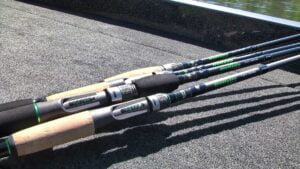
Dobyns Fury Rod Review
The Fury is a well-balanced and sensitive rod that is offered in a number of different presentation specific models. Whether you’re looking for a topwater, flipping, crankbait or other type of rod, the Dobyns Fury has a model right for you. While the Fury series isn’t without its flaws, the positives of this rod far outweigh any nitpicking we could do. Read our full thoughts here.
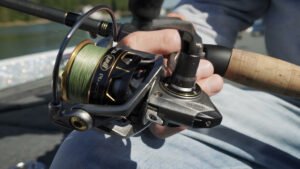
Lews Custom Pro Spinning Reel Review
Discover the Lews Custom Pro Spinning Reel – a high-performance reel with an all-aluminum body, flush-and-drain ports, a C60 carbon Skeletal Speed Rotor, and aluminum bailwire. Pre-lubricated with Lews Speed Lube, this reel is perfect for bass anglers who want a reliable and high-performing spinning reel. Read the full review at BassNedge.com!

RayBan Predator 2 Sunglasses Review
Who else loves a good pair of sunglasses? We do! We’ve had the chance to test out the Ray-Ban Predator 2 Sunglasses and we’re excited to share our thoughts with you. Whether you’re looking for a new pair of fishing sunglasses or just a great pair of sunglasses for everyday wear, the Ray-Ban Predator 2 Sunglasses are worth checking out. Keep reading to see what we thought!












